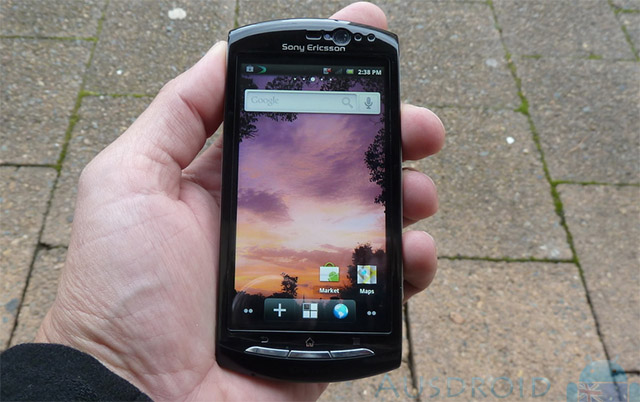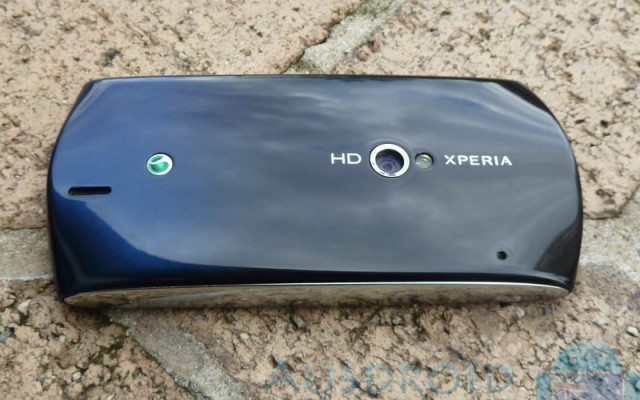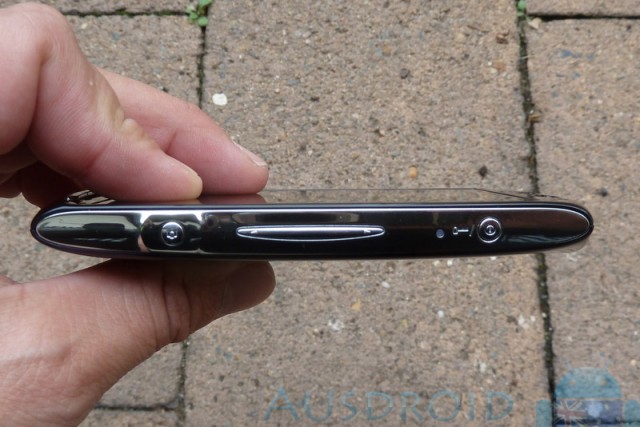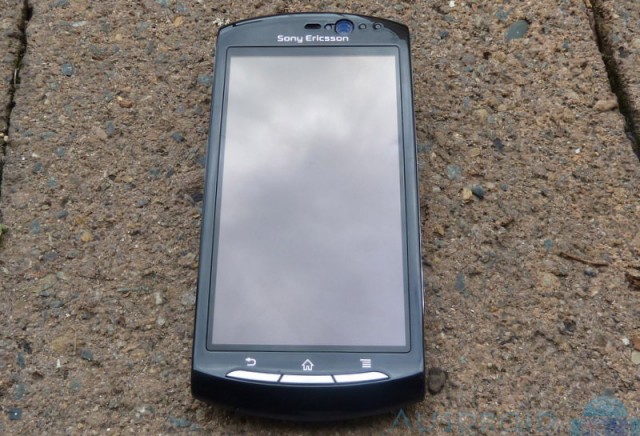
The Sony Ericsson Neo is a beautiful-looking phone. With its curves, chrome sides and black to blue colour transition on the back I immediately fell in love with this phone. Is the love more than skin deep? Read on to see..
Pros..
- Beautiful unique styling
- Outstanding camera
- Great quality music playback and included earphones
- HD voice capable
Cons..
- No dedicated search button, even long press on menu
- Physical buttons rather than soft buttons
- No light sensor (?)
- Some functions suffer from poor memory management

Hardware..
The first thing that struck me about the Xperia Neo is how good it looks, I couldn’t wait to get my hands on it. Sony Ericsson have put a lot of effort into the styling of this phone which is impressive as a lot of other manufacturers focus on specs with looks as an afterthought.
Build..
The Neo feels very nice in the hand, the back is slightly curved so it fits naturally in your palm. The back cover is black at the top and transitions to blue at the bottom. The sides of the phone are chrome, the left hand side has no buttons at all just a nice clean chrome edge. The right hand side has the power button, notification LED, volume rocker and the camera button. The volume rocker is in the middle of the phone and took me a little while to get used to the location. Notification LED on the side of the phone is a little unusual but still does the job. The camera button is slightly indented which makes it quick and easy to find. On top of the phone you have the 3.5mm headphone jack in the centre, with little hatches for the microUSB on the left and mini HDMI on the right. An HDMI cable is not included, but the phone does support HDMI mirroring. The hatches are good to keep dust out of the ports but you will need a fingernail to open them, this annoyed me after a few days. On the front of the phone is a 1.9MP camera for video calling, although with a camera that good on the front it’s also useful for self portraits. At the bottom are 3 chrome physical buttons – back, home and menu from left to right. Only the home button or the power button will wake the phone from sleep. There is no dedicated search button and long pressing menu will not bring up the search dialog as it does on some other 3 button phones.
Overall the build is solid and looks high quality. Over time the glossy back is likely to get scuffed from sitting on desks and tables, and the chrome hard buttons at the bottom may also become scuffed from constant use, however this is unlikely to be an issue in the short term.
Display..
The Neo has a brilliant LED backlit LCD screen powered by Sony’s Mobile Bravia Engine, and it is very impressive to look at. The screen is 3.7” and 480×854 pixels, a slightly unusual resolution as most in this range are 480×800. Another unusual aspect of the screen is that it doesn’t seem to have a light sensor to automatically adjust the brightness according to the environment. There is no ‘auto brightness’ setting under display as with most phones, and I couldn’t see a light sensor listed under the hardware specs. The consequence of this is that you will have to manually adjust the brightness when moving from a dark room to outside, or alternatively you could keep the display on full brightness but this is likely to hit your battery life. Regardless, at a PPI (pixel density) of just under 267 the screen looks crisp and bright and is an absolute pleasure to use.
CPU..
Powering the Xperia Neo is a Qualcomm MSM8255 Snapdragon CPU and Adreno 205 GPU, also found in the HTC Desire HD, HTC Incredible S and big brother Xperia Arc to name a few. Paired with this is 512MB of ram to produce acceptable but not outstanding performance. 320MB of onboard storage is available for app data which will be enough for light to medium users, but insufficient for heavy app downloaders. Luckily an 8GB microSD card is included with the phone, which can be replaced or swapped with support for up to 32GB microSD cards. In good news the microSD card is not hidden underneath the battery so the card can be swapped without turning the phone off.
Camera..
In my opinion the standout feature of the Xperia Neo is the 8MP camera with Exmor R mobile sensor. The camera on this phone is so good that I found myself taking more pictures than I ever have with previous phones. The dedicated camera button on the side of the phone will give you direct access to the camera application once the phone is awake, albeit a little slower to open the interface than I would have liked. Ideally I also would have preferred if the button was able to wake the phone and open the camera app too, but this is not the case. When in camera mode the unusual placement of the volume rocker makes a lot more sense as it allows you to zoom in and out. You can choose 8MP in 4:3 or 6MP in 16:9 format. To take photos you have two choices – use the two-stage hardware button on the side to focus and take a photo, or press anywhere on the screen to take a photo. The ability to press anywhere on the screen is simple but effective and makes it much easier to take a quick photo, because lets face it the ability to take a photo quickly is the key in most situations.
The Exmor R sensor allows photos to be taken even in low light conditions, something that most phone cameras struggle with. Switching to video mode is quick and easy via an option on the screen, where the camera will shoot 720p @30fps with continuous autofocus. Coupled with the LED flash and smile detection, this is easily the most capable camera I have ever used on a phone. Take a look at the examples below and see what you think.
[nggallery id=85]
Battery..
The battery is a 1500mAh which is about average for a phone of this size and specification. I was able to get a full day with medium to heavy use out of one charge so I rate the battery life as above average. This involved listening to music for 2 hours while web surfing and checking twitter, a few calls and messages throughout the day, followed by 2 more hours of web surfing and checking twitter.
Telephony..
The model I have, the MT15a, supports 850/1900/2100 HSDPA at 7.2Mbps down and 5.76Mbps up. I used my Telstra prepaid sim for the week and found the reception and data speeds to be about the same as my regular phone, the Motorola Atrix. Note that I spend most of my time around the Sydney metro area which arguably has probably the best reception in the country, so your mileage may vary depending on your location.
HD Voice is a relatively new technology, and your ability to take advantage of it will require the person on the other end of your conversation to also have a handset and network that supports HD Voice. If you’re talking to someone whose phone does not support HD Voice then you will notice no difference at all. But if you do have a friend whose phone supports HD Voice then you will probably find yourself talking to them a lot more often, because HD Voice sounds fantastic. You may be thinking that current call quality is acceptable and there is no need for HD Voice, but you probably thought the same thing about analogue TV before digital TV was released. Comparing a normal mobile call to HD Voice is like comparing a 128k MP3 file to a 320k MP3 file, the sound is fuller and clearer. While HD Voice is a feature you may not be able to use much right now, it is certainly worth having as adoption picks up.
Software..
Prior to the Xperia Neo I had never used a Sony Ericsson phone, but I was aware that they are not well known for their blisteringly fast performance or updating their phones. To my surprise the phone overall performs quite well, with some exceptions, and is running a recent version of android. The Neo runs Android 2.3.3 with a skin over the top that generally adds some useful features. The default launcher has 5 screens with the middle set as home, try as I might I could not figure out how to add or remove screens nor change the default homescreen, however this is not a major issue as you can easily set an alternative launcher such as ADW Launcher or LauncherPro. Sticking with the default launcher will allow you to use the included widgets such as Timescape, which is a visual representation of your calls and SMS. I found this to be nice eye candy but ultimately not very useful, however on the positive side the animations worked very well and performance of this widget was great.
Facebook integration is another great feature and in some ways is implemented better than HTC’s dedicated Facebook phone. When playing a song on the installed music player you can press a button to immediately share that song to your Facebook wall, not just post the title but the song, artist and album art. This is achieved via TrackID technology installed on the phone which is similar to Shazam or Soundhound and will identify the song based on a short sample. It also works on songs playing externally to the phone that can be identified through the phone’s microphone. The gallery also enjoys Facebook integration which will automatically pull your Facebook albums so you can browse them, ‘like’ them and add comments all directly from the phone’s gallery.
Performance when switching between apps was a little slower than I like, plus the phones music player did suffer from interference when using other apps in the background. It’s also missing some features I have become accustomed to on other phones, like smart dialing, however this can be achieved via third party apps. Overall I found the performance acceptable and about what I would expect from a phone with these hardware specifications.
Root..
The bootloader on the Neo is able to be unlocked and root can be achieved if that’s where your interest lies. Bootloader unlocking is allowed by Sony Ericsson, and to some extent encouraged on their Developer World, which is a refreshing attitude from a manufacturer at a time when consumers are crying out for more freedom on their device. Unfortunately the Neo does not have a dedicated forum on XDA and there is little evidence of community interest in developing for the Neo, however the ability is there and interest may grow as the Neo is released around the world.
Benchmark..
Quadrant score is 1423 and Neocore is 60.9, quite solid results against phones running the same hardware such as the Incredible S and Arc.
| Neocore (Frames/sec) | Quadrant (Higher = better) | |
|---|---|---|
| HTC Desire | 28.1 | 1240 |
| Xperia Play | 59.8 | 1351 |
| Xperia Arc | 58.3 | 1579 |
| Motorola Atrix | 54.1 | 2801 |
| Galaxy S II | 59.8 | 3428 |
| Sensation | 57.8 | 1968 |
| Incredible S | 56.5 | 1265 |
| Xperia Neo | 60.9 | 1423 |
Conclusion..
I really liked the Xperia Neo, it’s a stylish device with a solid build and it’s also a good size. On the hardware side, the camera is outstanding and probably the best mobile phone camera I have ever used, the screen is a pleasure to use, and HD Voice is a feature that will become more useful as time goes on . The software is also good with fancy screen transitions, seamless Facebook integration and other nice features such as TrackID. The Xperia Neo will be available for $0 upfront on Telstra’s $59 Freedom Connect Plan over 24 months which includes $550 of calls, unlimited txt and 1.5GB of data.






I can confirm that this phone does indeed have a light sensor. Its the white dot right near the front camera.
I’m thinking of getting this phone outright. But then wouldnt it be a waste to buy the next G compatible handset outright from telstra when I’m not going to be using telstra network?
Thanks for helping me decide on which phone to get. There are so many out there these days and with all this features and complicated buttons and cameras, its nice to know that something simple with everything you need still exists.
I think this site needs to put some screen grabs within the review so we can see the user interface of handsets a bit more. Of course we can all alter the appearance however seeing the actual software and skins as it comes from the factory would be a great addition.
I went and played with it at the telstra store today.
The size and screen are very nice, it is also extremely light.
Browser performance was quite good too (zooming / scrolling etc)
X10 Gingerbread is out! X10 Gingerbread is out!
Wooo! Snoopy Happy Dance!
The photographs taken by this phone are incredible! On my high definition laptop screen, they really do come out very clear – better than the other phones.
Hardware buttons aren’t necessarily a disadvantage. Some of us prefer them. I reckon that one’s going to be down to personal preference.
I prefer them because it’s easier to hit them by feel. But in principle the two-soft with a hard in the centre scheme Samsung have been using lately is probably a decent compromise.
If it weren’t for the lousy amount of storage available for apps I’d be mightily tempted. I am *so* over juggling apps around on my Desire…
Some people will prefer the hardware buttons as they can feel their way around the phone without looking, some people won’t like them – i’m on the “dont like them” side. As you said, personal preference. The onboard storage is small, but movement of data to the external SD is automatic and seamless. I installed all my usual apps and later found that the phone had relocated what it could to the external SD, no actions required on my behalf. This is completely different to the Salsa where user intervention was required to manage app storage. Don’t let app storage… Read more »
I’m a Telstra guy (network-wise), otherwise I’d probably go buy one for $399 on today’s special.
The Telstra capable version is $435 on SmoothMobiles which is a pretty good price.
http://www.smoothmobiles.com.au/sony-ericsson-xperia-neo-nextg.html
Yep, I’m sold now. So buying this.